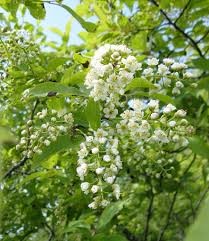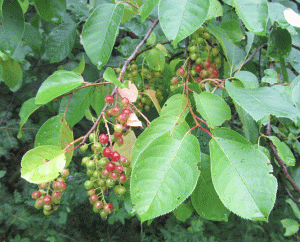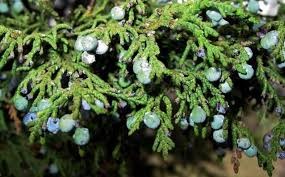Guided Trail Home | Locations | Geology | Vegetation | Wildlife | Wellness | Photography Tips
Vegetation
Snake River Canyon provides a rich ecosystem and wildlife habitat. Pick up a birding or wildlife checklist at the Visitor Center.
Common Name of Plant: American Elm
Scientific Name of Plant: Ulmus americana
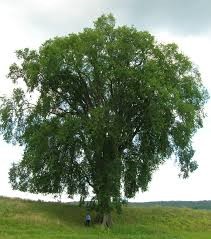
Importance of Plant: This majestic tree is highly adaptable and can grow in many different soil types. It is commonly cultivated and used for windbreaks for crops or homesteads. It is used by many animals as a source of food because of its seeds, tender shoots, and buds.
Fun Fact: The American Elm had been blighted by Dutch Elm Disease, but conservation efforts and hybridization have helped make this tree more resistant to disease and pests.
Common Name of Plant: Big Sagebrush
Scientific Name of Plant: Artemisia tridentata
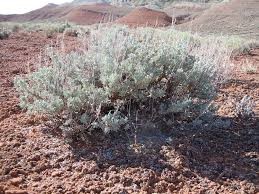
Importance of Plant: Big Sagebrush is an evergreen shrub that can grow up to 9 feet tall. The small leaves have a sweet, powerful smell and give the bush a blue-gray coloring. Sagebrush contains high levels of nutrients and is a valuable source of food and shelter for wildlife. Sagebrush also makes a great source of firewood because the same oils that provide the strong aroma are volatile enough to cause green plants to burn.
Fun Fact: Native Americans would drink a tea made from sagebrush to relieve sinus congestion. They also placed it in their shoes or moccasins to prevent foot odor.
Common Name of Plant: Black Cottonwood
Scientific Name of Plant: Populus trichocarpa
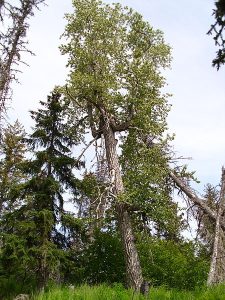
Importance of Plant: Because the wood is light colored and lightweight, the black cottonwood tree is primarily used to make particle board, plywood, veneer, and lumber. They are a fast growing tree that is a good source of food and shelter for a variety of animals, including deer, elk, and large birds that use the crowns for nesting sites. It is easy to establish and provides shade as well as serving as an effective windbreak.
Fun Fact: Native Americans used resin from this tree to treat sore throats, coughs, lung pain, and rheumatism.
Common Name of Plant: Black Locust Tree
Scientific Name of Plant: Robinia pseudoacacia
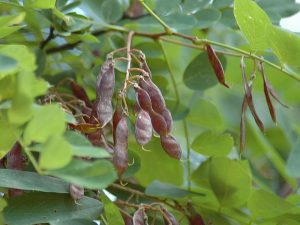
Importance of Plant: The black locust tree is an invasive species to Idaho and has often been given a bad name for its opportunistic, rapid growth and sharp thorns. This tree offers windbreaks, shelter, and food for many animals. It also serves as feed for some livestock and a food source for honeybees due to the similarity between the black locust and alfalfa.
Fun Fact: The Black Locust tree provides a high-density, rot resistant wood that makes it ideal for any projects that require weatherproof materials.
Common Name of Plant: Broadleaf Cattail
Scientific Name of Plant: Typha latifolia
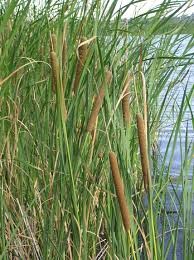
Importance of Plant: The Broadleaved Cattail can be found mainly around reservoirs, ponds, and streams throughout Idaho. It provides shelter for many small mammals and birds. Muskrats use the young shoots for food, as do some deer and elk species.
Fun Fact: The young shoots of the Broadleaved Cattail can be eaten raw or steamed.
Common Name of Plant: Cheatgrass
Scientific Name of Plant: Bromus tectorum
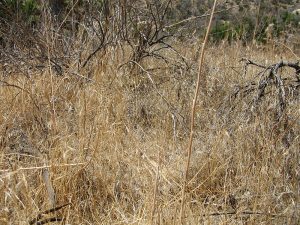
Importance of Plant: Cheatgrass is highly invasive annual weed throughout North America, particularly in western pastureland, rangeland, and winter wheat fields. When Cheatgrass first starts growing, it forms a lush, green landscape, that can provide quick initial cover after a fire. It matures quickly, turning a reddish purple when blooming, then tan when dormant, becoming an early season fire hazard. However, once established in rangeland, it makes establishment of more desirable grasses difficult.
Fun Fact: Cheatgrass is native to the Mediterranean region of the world and was introduced to the United States when it was used as packing material for products shipped into the country.
Common Name of Plant: Chicory
Scientific Name of Plant: Cichorium intybus
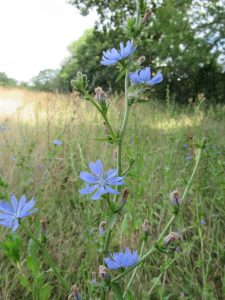
Importance of Plant: Chicory is native to Europe but was introduced to North America around 1900. It is commonly cultivated for use in coffee and as food for cattle. In many European countries the roots are boiled and served similarly to potatoes. The greens can also be used in salads.
Fun Fact: Using chicory to enhance coffee is very popular in New Orleans.
Common Name of Plant: Chokecherry
Scientific Name of Plant: Prunus virginiana
Importance of Plant: Chokecherry typically grows in thickets and can grow to be 30 feet tall. It forms dense white flowers and produces berries that vary from red to dark purple. Chokecherries have a sharp flavor when raw but are most commonly used to make preserves, jelly, juice, and syrup. Eating chokecherries without processing them first is not recommended due to the prussic (hydrocyanic) acid in the leaves, stems, and seeds.
Fun Fact: Native Americans and settlers used the chokecherry bark and roots to make sedatives, appetite stimulants, and medicinal teas to aid in treating coughs, tuberculosis, malaria, stomachaches and intestinal worms.
Common Name of Plant: Milkweed
Scientific Name of Plant: Asclepias speciosa

Importance of Plant: The milkweed plant is a native herbaceous perennial that grows on a wide variety of sites. It can grow to be 1 ½ – 5 feet tall. The leaves are covered in velvety hairs. Between May and September, milkweed blooms with rose-purple flower clusters. Milkweed has been used for fiber, food, and medicine since prehistoric times. The stalks provide a fiber that has been used for making rope, cord, and coarse fabric.
Fun Fact: Milkweed is the only plant on which monarch butterflies will lay their eggs and on which the larvae will feed. As the larvae feed on the milkweed, they ingest and sequester a toxic cardiac glycoside from the sap that makes the monarch caterpillars and adult butterflies t0xic to many predators.
Common Name of Plant: Bittersweet Nightshade
Scientific Name of Plant: Solanum dulcamara
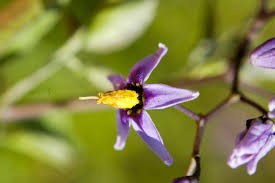
Importance of Plant: Bittersweet Nightshade, also known as Climbing Nightshade, is most commonly found between rivers and wooded areas and can grow as large as 10 feet. The primary pollinators for Bittersweet Nightshade are bumble bees. Though the purple flowers and red orange berries look appealing, they are actually toxic if ingested.
Fun Fact: Bittersweet Nightshade is native to Europe.
Common Name of Plant: Red Columbine
Scientific Name of Plant: Aquilegia canadensis
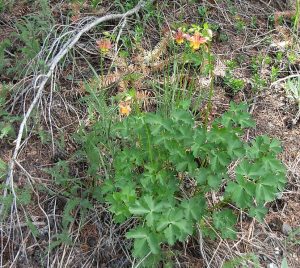
Importance of Plant: This lovely member of the buttercup family grows to 30 inches tall and has small, red, bell shaped flowers. It is most often found at the edge of wooded areas. It is an important food source for hummingbirds and honeybees.
Fun Fact: Red columbine has been used for a wide range of purposes from treating heart problems to use as a perfume.
Common Name of Plant: Rocky Mountain Juniper
Scientific Name of Plant: Juniperus scopulorum Sarg
Importance of Plant: The Rocky Mountain Juniper is a native tree in the western United States. It is a small evergreen tree that can grow to be 35 feet tall with a typical lifespan of 200-300 years. The Rocky Mountain Juniper is an important source of food and shelter, especially during the winter months, for pheasant, mule deer, and whitetail deer.
Fun Fact: Rocky Mountain Juniper berries are well known for their use in flavoring gin.
Common Name of Plant: Rubber Rabbitbrush
Scientific Name of Plant: Ericameria nauseosa
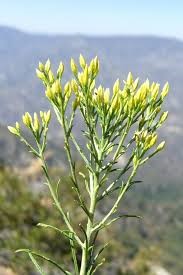
Importance of Plant: This warm season shrub grows to 8 feet tall with yellow green leaves and is covered in thin white hairs. It is used by some deer and elk species as a source of food and provides cover from the elements and predators for small mammals and birds. Rubber Rabbitbrush is also known to attract several species of insects including butterflies in the late summer season.
Fun Fact: Because it can grow in almost any soil type, Rubber Rabbitbrush is used in mine reclamation.
Common Name of Plant: Russian Olive Tree
Scientific Name of Plant: Elaegnus Angustifolia

Importance of Plant: The Russian Olive Tree is considered an invasive species to Idaho. Native to Europe and Asia, the exact date of introduction to the area is unknown but, we do know it was cultivated for a variety of uses such as shade, landscaping, and a source of food for honeybees.
Fun Fact: The Russian Olive was used extensively as windbreaks across the Great Plains of the U.S. in the 1930s and 1940s.
Common Name of Plant: Woods Rose
Scientific Name of Plant: Rosa woodsii
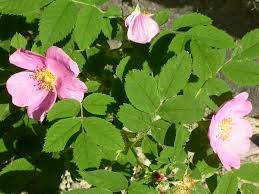
Importance of Plant: Commonly found in abundance in wetlands, this flowering plant can be found in a wide range of habitats. When several individual plants grow in the same area, they tend to create dense thickets ideal for small mammals seeking shelter from predators. The hips provide important food for many birds and mammals in the winter.
Fun Fact: Native Americans used a tea made from the bark of the Woods Rose to treat sore muscles.
Common Name of Plant: Yellow Monkey Flower
Scientific Name of Plant: Mimulus guttatus
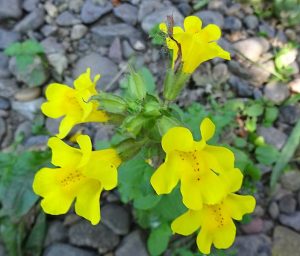
Importance of Plant: Yellow Monkey Flower is a leafy plant that grows to 3 feet tall. They can be small and spindly or large and bushy. They produce symmetrical yellow flowers with small purple dots on the lower petal. They grow in moist soil, typically along stream and riverbeds, and bloom between March and August.
Fun Fact: Another species of monkey flower, M lewisii, is partially carnivorous and uses small hairs on the leaves for trapping and eating insects.

